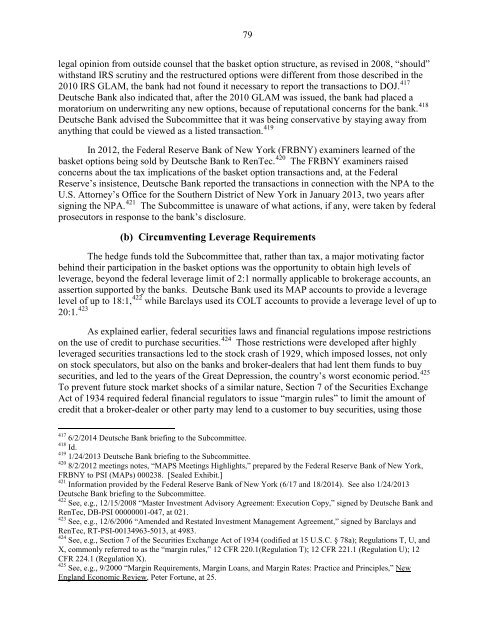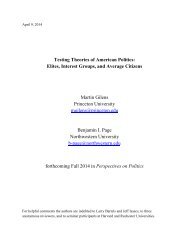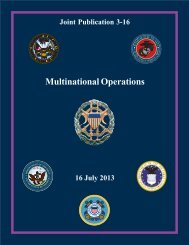ABUSE OF STRUCTURED FINANCIAL PRODUCTS- Misusing Basket Options to Avoid Taxes and Leverage Limits MAJORITY AND MINORITY STAFF REPORT
ABUSE OF STRUCTURED FINANCIAL PRODUCTS- Misusing Basket Options to Avoid Taxes and Leverage Limits MAJORITY AND MINORITY STAFF REPORT
ABUSE OF STRUCTURED FINANCIAL PRODUCTS- Misusing Basket Options to Avoid Taxes and Leverage Limits MAJORITY AND MINORITY STAFF REPORT
Create successful ePaper yourself
Turn your PDF publications into a flip-book with our unique Google optimized e-Paper software.
79<br />
legal opinion from outside counsel that the basket option structure, as revised in 2008, “should”<br />
withst<strong>and</strong> IRS scrutiny <strong>and</strong> the restructured options were different from those described in the<br />
2010 IRS GLAM, the bank had not found it necessary <strong>to</strong> report the transactions <strong>to</strong> DOJ. 417<br />
Deutsche Bank also indicated that, after the 2010 GLAM was issued, the bank had placed a<br />
mora<strong>to</strong>rium on underwriting any new options, because of reputational concerns for the bank. 418<br />
Deutsche Bank advised the Subcommittee that it was being conservative by staying away from<br />
anything that could be viewed as a listed transaction. 419<br />
In 2012, the Federal Reserve Bank of New York (FRBNY) examiners learned of the<br />
basket options being sold by Deutsche Bank <strong>to</strong> RenTec. 420 The FRBNY examiners raised<br />
concerns about the tax implications of the basket option transactions <strong>and</strong>, at the Federal<br />
Reserve’s insistence, Deutsche Bank reported the transactions in connection with the NPA <strong>to</strong> the<br />
U.S. At<strong>to</strong>rney’s Office for the Southern District of New York in January 2013, two years after<br />
signing the NPA. 421 The Subcommittee is unaware of what actions, if any, were taken by federal<br />
prosecu<strong>to</strong>rs in response <strong>to</strong> the bank’s disclosure.<br />
(b) Circumventing <strong>Leverage</strong> Requirements<br />
The hedge funds <strong>to</strong>ld the Subcommittee that, rather than tax, a major motivating fac<strong>to</strong>r<br />
behind their participation in the basket options was the opportunity <strong>to</strong> obtain high levels of<br />
leverage, beyond the federal leverage limit of 2:1 normally applicable <strong>to</strong> brokerage accounts, an<br />
assertion supported by the banks. Deutsche Bank used its MAP accounts <strong>to</strong> provide a leverage<br />
level of up <strong>to</strong> 18:1, 422 while Barclays used its COLT accounts <strong>to</strong> provide a leverage level of up <strong>to</strong><br />
20:1. 423 As explained earlier, federal securities laws <strong>and</strong> financial regulations impose restrictions<br />
on the use of credit <strong>to</strong> purchase securities. 424 Those restrictions were developed after highly<br />
leveraged securities transactions led <strong>to</strong> the s<strong>to</strong>ck crash of 1929, which imposed losses, not only<br />
on s<strong>to</strong>ck specula<strong>to</strong>rs, but also on the banks <strong>and</strong> broker-dealers that had lent them funds <strong>to</strong> buy<br />
securities, <strong>and</strong> led <strong>to</strong> the years of the Great Depression, the country’s worst economic period. 425<br />
To prevent future s<strong>to</strong>ck market shocks of a similar nature, Section 7 of the Securities Exchange<br />
Act of 1934 required federal financial regula<strong>to</strong>rs <strong>to</strong> issue “margin rules” <strong>to</strong> limit the amount of<br />
credit that a broker-dealer or other party may lend <strong>to</strong> a cus<strong>to</strong>mer <strong>to</strong> buy securities, using those<br />
417 6/2/2014 Deutsche Bank briefing <strong>to</strong> the Subcommittee.<br />
418 Id.<br />
419 1/24/2013 Deutsche Bank briefing <strong>to</strong> the Subcommittee.<br />
420 8/2/2012 meetings notes, “MAPS Meetings Highlights,” prepared by the Federal Reserve Bank of New York,<br />
FRBNY <strong>to</strong> PSI (MAPs) 000238. [Sealed Exhibit.]<br />
421 Information provided by the Federal Reserve Bank of New York (6/17 <strong>and</strong> 18/2014). See also 1/24/2013<br />
Deutsche Bank briefing <strong>to</strong> the Subcommittee.<br />
422 See, e.g., 12/15/2008 “Master Investment Advisory Agreement: Execution Copy,” signed by Deutsche Bank <strong>and</strong><br />
RenTec, DB-PSI 00000001-047, at 021.<br />
423 See, e.g., 12/6/2006 “Amended <strong>and</strong> Restated Investment Management Agreement,” signed by Barclays <strong>and</strong><br />
RenTec, RT-PSI-00134963-5013, at 4983.<br />
424 See, e.g., Section 7 of the Securities Exchange Act of 1934 (codified at 15 U.S.C. § 78a); Regulations T, U, <strong>and</strong><br />
X, commonly referred <strong>to</strong> as the “margin rules,” 12 CFR 220.1(Regulation T); 12 CFR 221.1 (Regulation U); 12<br />
CFR 224.1 (Regulation X).<br />
425 See, e.g., 9/2000 “Margin Requirements, Margin Loans, <strong>and</strong> Margin Rates: Practice <strong>and</strong> Principles,” New<br />
Engl<strong>and</strong> Economic Review, Peter Fortune, at 25.







